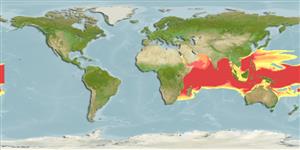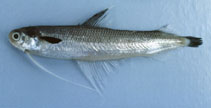Bregmaceros mcclellandi Thompson, 1840
Unicorn cod
Adicionar as suas observações no Fish Watcher
| Native range | All suitable habitat | Point map | Year 2050 |

|
| This map was computer-generated and has not yet been reviewed. |
| Bregmaceros mcclellandi AquaMaps Data sources: GBIF OBIS |
Adicionar o seu Fotografias e vídeos
Pictures | Imagem do GoogleBregmaceros mcclellandi
Picture by Gloerfelt-Tarp, T.
Pictures | Imagem do GoogleBregmaceros mcclellandi
Picture by Gloerfelt-Tarp, T.
India country information
Common names:
[No common name]
Occurrence: native
Salinity: marine
Abundance: | Ref:
Importance: minor commercial | Ref: FAO, 1994
Aquaculture: | Ref:
Regulations: | Ref:
Uses: no uses
Comments: Found in west coast around Mumbai (Ref. 45255). Most likely the species caught in large numbers off the west coast of India (A.S. Harold, pers. comm., 18/08/98). Also Ref. 1371, 115138, 115094.
National Checklist:
Country Information: https://www.cia.gov/library/publications/resources/the-world-factbook/geos/in.html
National Fisheries Authority:
Occurrences: Occurrences Point map
Main Ref: Kapoor, D., R. Dayal and A.G. Ponniah, 2002
National Database:
Occurrence: native
Salinity: marine
Abundance: | Ref:
Importance: minor commercial | Ref: FAO, 1994
Aquaculture: | Ref:
Regulations: | Ref:
Uses: no uses
Comments: Found in west coast around Mumbai (Ref. 45255). Most likely the species caught in large numbers off the west coast of India (A.S. Harold, pers. comm., 18/08/98). Also Ref. 1371, 115138, 115094.
National Checklist:
Country Information: https://www.cia.gov/library/publications/resources/the-world-factbook/geos/in.html
National Fisheries Authority:
Occurrences: Occurrences Point map
Main Ref: Kapoor, D., R. Dayal and A.G. Ponniah, 2002
National Database:
Common names from other countries
Classificação / Names Nomes comuns | Sinónimos | Catalog of Fishes(Género, Espécies) | ITIS | CoL | WoRMS | Cloffa
> Gadiformes (Cods) > Bregmacerotidae (Codlets)
Etymology: Bregmaceros: Greek, bregma = front of the head + Greek, keras, -atos = horn (Ref. 45335).
Eponymy: John McClelland (1805–1875) was a British doctor with interests in geology and natural history. [...] (Ref. 128868), visit book page.
Etymology: Bregmaceros: Greek, bregma = front of the head + Greek, keras, -atos = horn (Ref. 45335).
Eponymy: John McClelland (1805–1875) was a British doctor with interests in geology and natural history. [...] (Ref. 128868), visit book page.
Environment: milieu / climate zone / depth range / distribution range Ecologia
marinhas; estuarina; oceanódromo (Ref. 51243); intervalo de profundidade 0 - 2000 m (Ref. 26165). Subtropical; 25°N - 6°N, 62°E - 100°E
Distribuição Países | Áreas FAO | Ecossistemas | Ocorrências | Point map | Introduções | Faunafri
Indian Ocean: confirmed from the Arabian Sea and Bay of Bengal. Reports from outside this area are most likely misidentifications (A.S. Harold, pers. comm., 18/08/98) and name reported from western Pacific may be a misidentification of B. pseudolanceolatus (Ref. 114229).
Tamanho / Peso / Idade
Maturity: Lm ? range ? - ? cm
Max length : 9.6 cm SL macho/indeterminado; (Ref. 4496); common length : 7.0 cm SL macho/indeterminado; (Ref. 2872); peso máx. Publicado: 8.50 g (Ref. 128684)
Max length : 9.6 cm SL macho/indeterminado; (Ref. 4496); common length : 7.0 cm SL macho/indeterminado; (Ref. 2872); peso máx. Publicado: 8.50 g (Ref. 128684)
Descrição breve Chaves de identificação | Morfologia | Morfometria
Espinhos dorsais (total) : 0; Raios dorsais moles (total) : 57 - 66; Espinhos anais: 0; Raios anais moles: 58 - 69; Vértebras: 52 - 58. Body is elongate, brownish and with speckling above and silvery below. The cheek and lower head also silver. Single occipital ray long and delicate, extending to near the middle of the second dorsal fin (Ref. 46075). Pelvic fins are jugular.
If taxonomy is correct, both onshore in brackish water and oceanic. According to larval survey, occurrence in the tropics is wide (Ref. 9902, 45075). Feed on planktonic crustaceans. Also caught with bagnets (Ref. 2872).
Life cycle and mating behavior Maturidade | Reprodução | Desova | Ovos | Fecundidade | Larvas
Referência principal
Upload your references | Referências | Coordenador : Bailly, Nicolas | Colaboradores
Cohen, D.M., 1990. Bregmacerotidae. p. 524-525. In J.C. Quero, J.C. Hureau, C. Karrer, A. Post and L. Saldanha (eds.) Check-list of the fishes of the eastern tropical Atlantic (CLOFETA). JNICT, Lisbon; SEI, Paris; and UNESCO, Paris. Vol. 2. (Ref. 4496)
Ameaça para o homem
Harmless
Utilização humana
Pescarias: espécies comerciais
FAO(pescarias: produção; publication : search) | FishSource | Sea Around Us
Mais informação
Population dynamics
Parâmetros de crescimento
Max. ages / sizes
Length-weight rel.
Length-length rel.
Frequência de comprimento
Mass conversion
Recrutamento
Abundância
Parâmetros de crescimento
Max. ages / sizes
Length-weight rel.
Length-length rel.
Frequência de comprimento
Mass conversion
Recrutamento
Abundância
Physiology
Body composition
Nutrients
Consumo de oxigénio
Tipo de natação
Velocidade de natação
Visual pigments
Fish sound
Diseases & Parasites
Toxicity (LC50s)
Body composition
Nutrients
Consumo de oxigénio
Tipo de natação
Velocidade de natação
Visual pigments
Fish sound
Diseases & Parasites
Toxicity (LC50s)
Genetics
Genética
Heterozygosity
Hereditariedade
Genética
Heterozygosity
Hereditariedade
Human related
Aquaculture systems
Perfis para aquacultura
Estirpes
Ciguatera cases
Stamps, coins, misc.
Aquaculture systems
Perfis para aquacultura
Estirpes
Ciguatera cases
Stamps, coins, misc.
Ferramentas
E-book | Guia de campo | Ferramenta auxiliar de frequências de comprimento | Ferramenta sobre a história de vida | Mapa dos pontos | Classification Tree
| Catch-MSY |
Relatórios especiais
Descarregue XML
Fontes da internet
Aquatic Commons | BHL | Cloffa | Websites from users | Consultar FishWatcher | CISTI | Catalog of Fishes(Género, Espécies) | DiscoverLife | ECOTOX | Faunafri | Fishtrace | GenBank(genoma, nucleotídeo) | GloBI | GOBASE | | Google Books | Google Scholar | Google | IGFA World Record | MitoFish | Bases de dados nacionais | Otolith Atlas of Taiwan Fishes | PubMed | Reef Life Survey | Scirus | SeaLifeBase | Árvore da vida | Wikipedia(ir para, procurar) | World Records Freshwater Fishing | Zoobank | Registo zoológico
Estimates based on models
Preferred temperature (Ref. 115969): 5.6 - 13.1, mean 8.8 (based on 755 cells).
Phylogenetic diversity index (Ref. 82804): PD50 = 0.5001 [Uniqueness, from 0.5 = low to 2.0 = high].
Bayesian length-weight: a=0.00363 (0.00194 - 0.00680), b=3.16 (2.99 - 3.33), in cm Total Length, based on LWR estimates for this species & (Sub)family-body (Ref. 93245).
Nível Trófico (Ref. 69278): 3.3 ±0.42 se; based on food items.
Resiliência (Ref. 120179): Elevada, tempo mínimo de duplicação da população menor que 15 meses (Assuming tm=1).
Fishing Vulnerability (Ref. 59153): Low vulnerability (10 of 100).
Climate Vulnerability (Ref. 125649): Moderate to high vulnerability (48 of 100).




